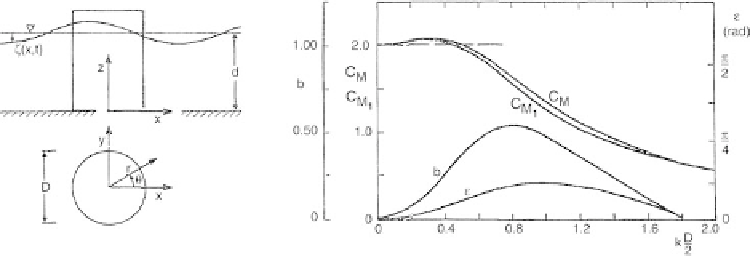Environmental Engineering Reference
In-Depth Information
Fig. 2.41 Vertical cylinder erected on the seabed; coef
cients c
M
,c
M1
, b and phase angle
e
after
MacCamy and Fuchs [17]
where J
m
is the Bessel (cylinder) function of the first kind and mth order [27] and
e
m
is
the so-called Neumann symbol (
e
0
¼
1;
e
m
¼
2 for m
1).
As a solution to the diffraction problem, we get the following for the velocity potential
(total potential
F
(r,
u
, z, t)):
1
g
H
2
v
cosh k
z
ð
Þ
Þ
e
i
v
t
m
¼
0
e
m
i
m
þ
1
F
ð
r
; u;
z
;
t
Þ¼
cosh k
d
ð
J
0
m
k
ð Þ
H
0
m
k
a
J
m
k
r
ð
Þ
Þ
H
m
k
r
ð
Þ
cos m
u
ð
Þ
ð
where
a radius of cylinder
Here, H
m
is the Hankel function of the first kind and mth order [27], and J
0
m
,H
0
m
are the
derivations of the functions according to their argument.
The following applies for the Hankel function of the first kind and mth order:
H
m
k
r
ð
Þ¼
J
m
k
r
ð
Þþ
i
Y
m
k
r
ð
Þ
where J
m
(k
r), Y
m
(k
r) are Bessel functions of the first and second kind.
All the variables of the flow field can be determined from the velocity potential. In real
notation, the force per unit height of the cylinder is
0
sin
dF
x
z
ðÞ
dz
;
@
u
¼ r p
a
2
c
M
1
ðÞ
ð
v
t
e
Þ
@
t






